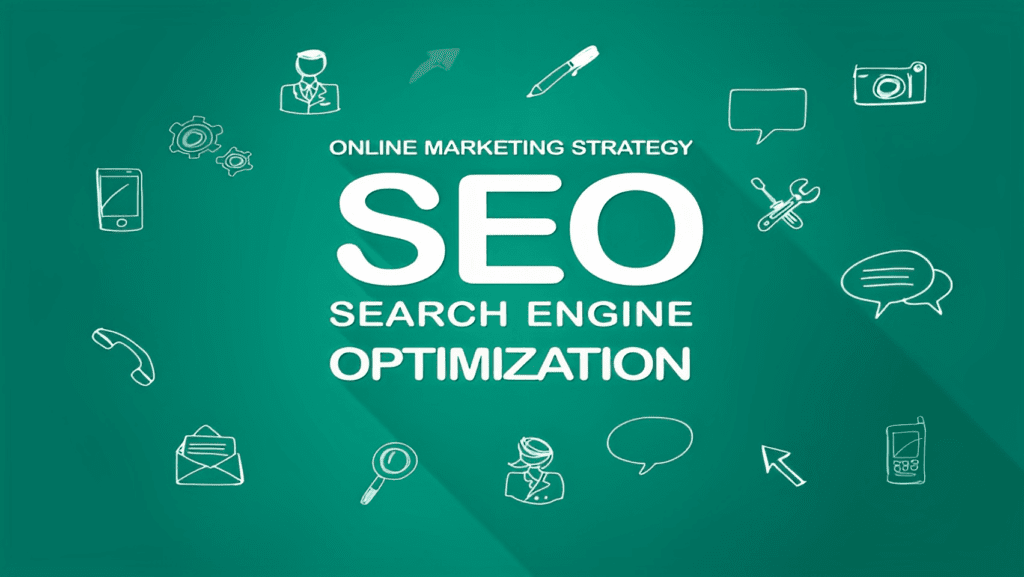How can website SEO contribute to company growth?
SEO stands for Search Engine Optimization. It refers to the practice of improving a website’s visibility and ranking in search engine results pages (SERPs). The goal of SEO is to optimize a website’s content, structure, and other factors to attract organic (non-paid) traffic from search engines like Google, Bing, or Yahoo.
Search engines use complex algorithms to determine the relevance and quality of web pages when users enter search queries. It involves various techniques and strategies to align a website with these algorithms and improve its chances of ranking higher in search results.

Classification of SEO:
There are three main types of SEO, each focusing on different aspects of optimizing a website for search engines. These are:
1. On-Page SEO:
- Keyword Optimization: Researching and incorporating relevant keywords into the website’s content, meta tags, headings, and URLs to improve its visibility for specific search queries.
- Content Creation: Developing high-quality, unique, and informative content that aligns with user intent and provides value. This includes using proper formatting, incorporating multimedia elements, and optimizing the length and readability of the content.
- HTML Tags Optimization: Optimizing title tags, meta descriptions, header tags (H1, H2, etc.), and image alt tags to accurately describe the content and increase its relevance in search results.
- Internal Linking: Creating a logical internal linking structure within the website to help search engines discover and navigate through the content more easily, while also improving user experience.
- URL Structure: Creating user-friendly URLs that are descriptive, concise, and include relevant keywords.
- User Experience (UX): Enhancing the overall user experience by ensuring fast loading times, mobile-friendliness, easy navigation, and a visually appealing design. [Contact us]
2. Off-Page SEO: It includes
- Link Building: Acquiring high-quality backlinks from reputable and relevant websites, as search engines view such links as votes of confidence for the website’s content and authority.
- Social Media Marketing: Leveraging social media platforms to promote the website’s content, engage with users, and encourage sharing and link acquisition.
- Influencer Outreach: Collaborating with influential individuals or entities within the website’s industry to gain exposure, attract relevant traffic, and earn backlinks.
- Guest Blogging: Writing and publishing articles on external blogs and websites to showcase expertise, gain visibility, and acquire backlinks.
- Online Reputation Management: Monitoring and managing the website’s online reputation by addressing customer reviews, comments, and mentions to maintain a positive brand image [Contact us]
3. Technical SEO:
- Website Speed: Optimizing the website’s loading times through techniques such as browser caching, image compression, minification of CSS and JavaScript files, and utilizing content delivery networks (CDNs).
- Site Structure and Navigation: Ensuring a logical and organized site structure that allows search engines to crawl and index the content effectively. This includes using XML sitemaps, optimizing the internal linking structure, and implementing breadcrumb navigation.
- Schema Markup: Implementing structured data markup (such as Schema.org) to provide search engines with additional context and information about the website’s content, which can lead to enhanced search result displays (rich snippets).
- Robots.txt and XML Sitemaps: Optimizing the robots.txt file to control search engine access to specific parts of the website and managing XML sitemaps to facilitate the crawling and indexing of pages.
- Mobile-Friendliness: Ensuring that the website is optimized for mobile devices, providing a seamless and responsive user experience across different screen sizes.
- SSL Certificate: Implementing HTTPS encryption to establish a secure connection between the website and its users, which is favored by search engines and improves user trust [Contact us]

Business Benefits of SEO:
SEO provides several business benefits that can contribute to its growth and success, Like
- Increased Website Traffic: SEO helps drive organic traffic to a website, which means attracting visitors who are actively searching for products, services, or information related to the business. By optimizing the website for relevant keywords and improving its visibility in search engine results, it increases the chances of attracting high-quality, targeted traffic to the website.
- Improved Brand Visibility and Recognition: Ranking higher in search engine results establish greater visibility and exposure for a business. When a website appears on the first page of search results, users are more likely to trust and click on it, leading to increased brand recognition and awareness. Over time, consistent visibility in search results can position the business as an authoritative and trusted source within its industry.
- Enhanced User Experience: SEO involves optimizing various elements of a website, including its structure, navigation, and content. By improving the user experience, businesses can increase engagement, reduce bounce rates, and keep visitors on the site for longer periods. This positive user experience can lead to increased conversions, repeat visits, and customer loyalty.
- Competitive Advantage: In competitive industries, SEO can provide a significant advantage over competitors. By outranking competitors in search results, a business can attract more organic traffic and gain a larger share of the market. It allows businesses to stand out from the competition, differentiate their offerings, and capture the attention of potential customers.
- Cost-Effective Marketing: SEO is a cost-effective marketing strategy compared to other forms of digital advertising. While there may be upfront costs associated with optimizing a website and creating quality content, the ongoing maintenance and optimization costs are relatively low. Unlike paid advertising, where visibility ends once the budget is depleted, its efforts can generate long-term organic traffic without incurring additional costs.
- Higher Conversion Rates: Optimizing a website for targeted keywords and providing valuable content can lead to higher conversion rates. When users find the information or products they are looking for through organic search, they are more likely to convert into customers, subscribers, or leads. SEO-driven traffic tends to have higher intent and a greater likelihood of engaging with the business.
- Long-Term Business Growth: SEO is a long-term strategy that aims to establish a strong online presence and sustainable growth. By consistently implementing the best practices and adapting to algorithm changes, businesses can maintain and improve their search engine rankings over time. This can result in a steady flow of organic traffic and continuous business growth.
- Measurable Results and Insights: SEO allows businesses to track and measure various metrics, such as website traffic, keyword rankings, and user behavior. Tools like Google Analytics provide valuable insights into customer preferences, trends, and the effectiveness of SEO efforts. This data-driven approach enables businesses to make informed decisions, refine their strategies, and optimize their marketing efforts for better results.
- Local Business Growth: For businesses with physical locations, local SEO strategies can help increase visibility in local search results. By optimizing the website for local keywords, creating local business listings, and encouraging customer reviews, businesses can attract more local customers and drive foot traffic to their physical stores.
- Return on Investment (ROI): SEO can provide a higher return on investment than other marketing strategies. Since it targets users who are actively searching for specific products or services, the likelihood of converting those users into customers is higher. With proper optimization and tracking of conversions, businesses can measure the effectiveness of their SEO efforts and calculate the ROI.
- Targeted Marketing: SEO allows businesses to target specific keywords and demographics, ensuring that their website is visible to the right audience. By understanding the target market and optimizing the website accordingly, businesses can attract highly relevant and qualified traffic. This targeted approach increases the chances of converting visitors into customers and leads.
- Trust and Authority Building: SEO helps build trust and authority for a business. When a website consistently appears in search results for relevant queries, users perceive it as a reliable and trustworthy source. By providing valuable content, addressing user needs, and earning backlinks from reputable websites, businesses can establish themselves as experts in their industry and gain the trust of their target audience.
- International Expansion: For businesses looking to expand internationally, SEO can be a powerful tool. By implementing international SEO strategies, such as optimizing for different languages and countries, companies can target specific regions and attract global customers. This can open up new markets and opportunities for growth.
- Long-Term Business Asset: SEO efforts can have a lasting impact on a business. Unlike paid advertising, where visibility ends once the campaign is over, it can continue to generate organic traffic and leads over the long term. The optimization efforts put into the website, content, and online presence can serve as a valuable asset that continues to attract customers and drive business growth.
- Brand Association and Perception: Ranking higher in search results and appearing alongside reputable websites can positively impact a business’s brand association and perception. Users tend to trust businesses that have a strong online presence and are visible in search results. By optimizing their online presence through SEO, businesses can enhance their brand image and perception in the eyes of their target audience.
Finally, we can state that businesses can enhance their online presence, increase brand visibility, attract targeted traffic, and drive sustainable growth. SEO is an essential component of a comprehensive digital marketing strategy and can yield significant long-term results for businesses across various industries.
Developing Bangladesh Bangladesh Trade Center To know more, click here!

